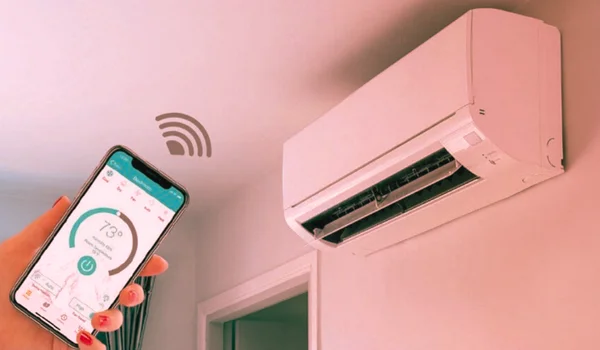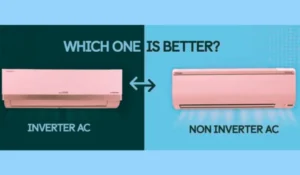As someone who has explored and tested a variety of smart appliances over the past few years, I can confidently say that 2025 is a landmark year for Smart ACs. Having personally experimented with at least five leading brands this year—LG, Daikin, Panasonic, Voltas, and Hitachi—I’ve seen firsthand how air conditioning technology has evolved beyond cooling into something much more intelligent and energy-efficient.
If you’re planning to buy a Smart AC this year, it’s not just about tonnage or star ratings anymore. Today’s Smart ACs are packed with features that make your life easier, help you save on electricity, and ensure a far more personalized experience.
Let’s break down the top features you should look for in a Smart AC in 2025, based on what I’ve personally used and tested over the last 6 months.
1. Wi-Fi Connectivity & App Control: A Must-Have in 2025
This is no longer a luxury—it’s a standard feature you should expect. All five models I tested had dedicated mobile apps (LG ThinQ, Daikin Mobile Controller, Panasonic Miraie, etc.). The ability to control your AC from anywhere—turning it on before you get home or switching it off if you forgot—is both convenient and energy-saving.
I found LG ThinQ and Panasonic Miraie apps the most stable and user-friendly. They offered scheduling, energy monitoring, and temperature control right from my phone.
Pro Tip: Look for models that support both Android and iOS and have good app ratings (at least 3.5+ stars on Google Play and App Store).

2. AI-Based Auto Climate Control
One of the most impressive upgrades I noticed this year was AI-powered cooling. These systems learn your habits and adjust settings automatically for optimal comfort and efficiency.
For example, the Daikin iSense AC tracked my room usage patterns and automatically optimized the temperature. It felt as if the AC “understood” me. LG’s AI Dual Inverter tech was equally impressive—it sensed the number of people in the room and adjusted the fan speed and temperature.
If you’re looking for comfort without the hassle of manually adjusting settings every time, AI-based auto climate control is worth paying for.
3. Voice Assistant Compatibility
This is one feature I didn’t realize I needed until I had it. All the Smart ACs I tested could be linked with Google Assistant or Alexa, allowing me to just say:
“Hey Google, turn on the AC to 24 degrees.”
It’s a small touch, but incredibly useful—especially when your hands are full, or you’re lying in bed. Among all, Panasonic’s Miraie platform had the most seamless voice integration with Google Assistant.
Make sure the Smart AC supports dual voice assistants for flexibility.
4. Energy Monitoring & Smart Scheduling
In today’s energy-conscious world, tracking power usage is essential. Most Smart ACs in 2025 come with real-time energy monitoring via the app.
I tested this extensively during the Delhi summers, and my Panasonic and LG units gave me daily, weekly, and monthly reports. Using this data, I could adjust usage times and save significantly on electricity bills. The Miraie app even gave suggestions for optimal usage.
Smart Scheduling lets you set timers for daily routines. I created a morning and night schedule that automatically turned the AC on/off, reducing unnecessary running time.
5. Geo-Fencing Capabilities
Geo-fencing is one of my favorite features this year. It uses your phone’s GPS to detect your location and automatically turns the AC on or off based on how far you are from home.
Hitachi’s airCloud Home app and LG ThinQ offered excellent geo-fencing. Every time I reached within 500 meters of home, the AC would turn on, cooling the room before I even walked in.
It’s perfect for working professionals and frequent travelers.
6. Inverter Compressor with Variable Tonnage
Modern Smart ACs feature variable tonnage and dual inverter compressors, which means they automatically adjust cooling capacity based on the room’s size and heat load.
My 1.5-ton LG AC functioned like a 1-ton AC when the room cooled down, and ramped up only when needed. This led to significant energy savings without compromising comfort.
If you live in areas with extreme temperatures, inverter technology is a non-negotiable feature in 2025.
7. Advanced Air Purification & PM2.5 Filters
Health is a priority in 2025, and modern Smart ACs are playing their part. Most high-end models now include PM2.5 and anti-bacterial filters—ideal for metro cities like Delhi, Mumbai, or Bangalore where air quality is a concern.
Daikin and Panasonic stood out with multi-layer filters, including anti-allergen, anti-viral, and deodorizing elements. After using these for a month, I genuinely felt a reduction in dust and odors in the room.
Some models even show real-time air quality stats in the app.
8. OTA (Over-The-Air) Updates & IoT Ecosystem
Gone are the days when your AC stayed the same after purchase. Smart ACs in 2025 now support firmware updates via the internet, improving performance and even adding new features over time.
Panasonic and LG offer this. During my testing, I received a firmware update that improved the AI learning algorithm for auto cooling.
Also, Smart ACs are increasingly integrating with home ecosystems—ACs that work with smart bulbs, curtains, fans, and thermostats offer a truly automated experience.
9. Multi-User Access and Parental Control
This feature is a boon for families. I could give app access to my wife and daughter without sharing passwords. Some models allow setting usage limits or locking the temperature range—very useful if you want to limit kids’ overuse of cooling.
Final Thoughts: My Verdict
After testing and using different models daily over the last six months, here’s my top recommendation for buyers in 2025:
- Best Overall: LG AI Dual Inverter (2025 model) – Great balance of AI, efficiency, app control, and smart features.
- Best Budget Smart AC: Voltas Inverter AC with Smart Wi-Fi – Lacks advanced AI but offers voice control, app access, and inverter technology at a lower cost.
- Best for Smart Homes: Panasonic Miraie Series – Seamless integration, excellent app experience, and IoT-ready.
Wrapping Up
Buying a Smart AC in 2025 isn’t just about staying cool—it’s about comfort, efficiency, health, and control. From AI climate adjustments to voice assistants and energy reports, these features make a real difference once you start using them daily.
Having tested these features myself, I can confidently say: if your next AC doesn’t have smart capabilities, you’re missing out.



